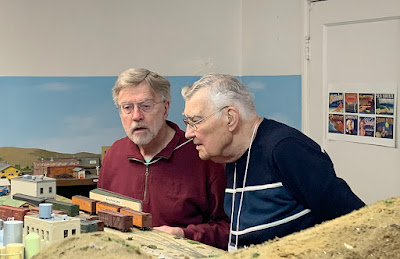But until recently there was no storage tank for diesel fuel in the Shumala engine terminal, so no need to spot tank cars of that fuel anywhere. That changed when I finally added diesel fuel storage a few months ago (for a description and photo, see this post: https://modelingthesp.blogspot.com/2022/12/adding-storage-tanks.html ). That post also shows one of SP’s tank cars with the distinctive aluminum-painted end band, the diesel fuel scheme used after 1951.
But SP originally (in the late 1930s, to service the diesel locomotives of the City of San Francisco, SP’s only diesels at the time) had painted such cars with aluminum tanks and black lettering, and continued to use that scheme into the 1950s. I wanted to model one.
Below is a photo of the left side of one such car, SP 58409 (at left of the photo is the end of an aluminum-stripe car, as mentioned above). Built in the summer of 1928, SP 58409, Class O-50-12, received the all-aluminum scheme in 1948 when it was assigned to diesel fuel service. The photo was taken at Los Angeles on January 22, 1955 (Chet McCoid photo, Bob’s Photo collection, used with permission). The spillage, incidentally, is another modeling goal!
[For more on these tank cars and their paint schemes, you may consult Chapter 14 of my book, Southern Pacific Freight Cars, Volume 5: Hoppers, Covered Hoppers, and Tank Cars (Signature Press, 2008).]
To model a car like this, I used my normal modification to the Athearn “42-foot” tank car. I posted a full description of this process some time ago (see it at: https://modelingthesp.blogspot.com/2011/05/modeling-sp-tank-cars.html ). Accordingly, I won’t go into those preparatory steps, except to show the core of the work on the tank body, as described in the post just cited.
Below is an illustrative photo of an Athearn body. The dome height has been corrected by adding the top of another dome, the safety valves have been re-located to their correct position, the dome walk on the near side has been removed, and I have sanded off the extraneous rivet rows near the dome on the original body. The safety valves were always toward the B end of the car, thus the removed walk was on the right side.
The present project is intended to correct mistakes in a project that’s been stalled for several years, because of an error I made. Below, I show the modeling at the point that the dome height has been corrected but the dome walk was removed on the wrong side (typical SP practice to have a walk only on one side, the left). You can see I have already done some lettering. Note also the new wire grab irons at tank ends. The next step on the body is to correct the wrong-side walk removal, and to make a new handrail.
One option would be to remove the walk on the far side of the model shown above, and build a new one on the near side. But there is a simpler solution: remove the safety valves from their location shown above, and re-install them on the other side of the manway cover. Since those valves are always toward the B end, moving them immediately makes the walk-less side into the right side of the car.
Once that correction is made, next comes work on the frame. To the kit underframe, I usually add some brake piping and rigging with wire, because it is so visible on tank cars. Below is an illustration of a minimal amount of this modification.
Before going any further, I should mention that SP’s silver diesel fuel tank cars had black bottom sheets. Commercial models have sometimes missed this point, but prototype photos are quite clear (for example, see the one at the top of the present post).
For another example, the view below was taken at Tucumcari, New Mexico on December 17, 1947, and though the photographer doubtless was far more interested in Class AC-9 no. 3807, it’s also a fine view of the left side of diesel fuel tank car SP 58691, Class O-50-13 (Al Phelps photo).
Correcting the dome top and forming a handrail are the first tasks. Then, regarding finishing, obviously I need to add a black bottom sheet to my model, along with touching up the body paint and completing lettering. I will return to this modeling project in a future post.
Tony Thompson
















































